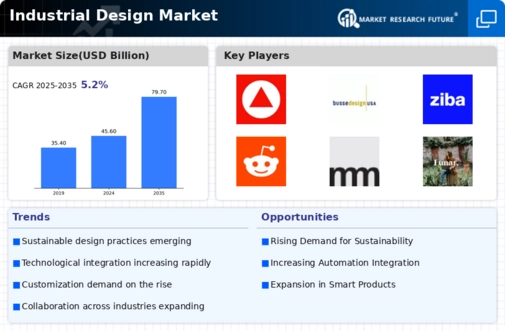Sustainability Trends
Sustainability has emerged as a pivotal driver in the Global Industrial Design Market Industry. With growing awareness of environmental issues, designers are increasingly focusing on creating eco-friendly products. This shift is reflected in the materials used, with a preference for recyclable and biodegradable options. Companies are also adopting sustainable practices in their design processes, which not only appeal to environmentally conscious consumers but also comply with regulatory standards. The emphasis on sustainability is likely to contribute to the market's growth, with projections indicating an increase to 79.7 USD Billion by 2035.
Globalization of Markets
Globalization plays a crucial role in shaping the Global Industrial Design Market Industry. As companies expand their operations internationally, they require design solutions that cater to diverse cultural preferences and market needs. This globalization fosters collaboration among designers from different regions, leading to innovative design concepts that appeal to a broader audience. Furthermore, access to global markets allows for the exchange of ideas and best practices, enhancing the overall quality of industrial design. This interconnectedness is likely to drive market growth as businesses seek to capitalize on global opportunities.
Market Growth Projections
The Global Industrial Design Market Industry is projected to experience substantial growth in the coming years. With a market value of 45.6 USD Billion in 2024, the industry is anticipated to expand significantly, reaching 79.7 USD Billion by 2035. This growth trajectory suggests a robust CAGR of 5.2% from 2025 to 2035, indicating a healthy demand for innovative design solutions across various sectors. The increasing integration of technology, sustainability practices, and customization trends are likely to drive this growth, positioning the industry for a dynamic future.
Technological Advancements
The Global Industrial Design Market Industry is experiencing a surge in technological advancements that enhance design processes and product functionality. Innovations such as 3D printing, computer-aided design (CAD), and virtual reality are revolutionizing how products are conceptualized and developed. These technologies enable designers to create prototypes more efficiently, reducing time-to-market and costs. As a result, companies are increasingly adopting these technologies to stay competitive. The market is projected to reach 45.6 USD Billion in 2024, driven by the need for faster and more efficient design solutions.
Consumer Demand for Customization
The Global Industrial Design Market Industry is witnessing a notable shift towards customization, driven by consumer preferences for personalized products. As consumers seek unique solutions tailored to their specific needs, designers are responding by offering customizable options. This trend is particularly evident in sectors such as furniture and consumer electronics, where brands are leveraging design flexibility to enhance customer satisfaction. The increasing demand for customized products is expected to propel market growth, aligning with the projected CAGR of 5.2% from 2025 to 2035.
Regulatory Compliance and Standards
Regulatory compliance is increasingly influencing the Global Industrial Design Market Industry. Governments worldwide are implementing stringent regulations regarding product safety, environmental impact, and quality standards. Designers must navigate these regulations to ensure their products meet legal requirements, which can complicate the design process. However, adherence to these standards can enhance a company's reputation and marketability. As the industry evolves, the importance of compliance is expected to grow, potentially impacting design strategies and contributing to the overall market dynamics.







